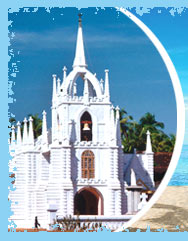 The
history of Goa is steeped in mythological roots. An ancient land, Goa
finds mention in Hindu epics as Gomantak, literally meaning 'fertile
land with plentiful water.' The first major dynasty to have ruled over
Goa was the Satavahanas under who Goa flourished as a prominent center
of maritime trade. After the fall of the Satavahana Empire, a number of
Hindu kingdoms including the Bhojas, badami Chalukyas and the Kadambas
held sway in the land of Goa.
The
history of Goa is steeped in mythological roots. An ancient land, Goa
finds mention in Hindu epics as Gomantak, literally meaning 'fertile
land with plentiful water.' The first major dynasty to have ruled over
Goa was the Satavahanas under who Goa flourished as a prominent center
of maritime trade. After the fall of the Satavahana Empire, a number of
Hindu kingdoms including the Bhojas, badami Chalukyas and the Kadambas
held sway in the land of Goa.As these kingdoms gradually faded into the sunset, Goa became the target of Muslim invaders who indulged in mass scale destruction and looting of temples. The carnage was brought to a halt when the Vijayanagar rulers annexed Goa in 1378. But the Bahmani Sultanate invaded Goa again in 1470 and subsequently Goa came under the rule of Sultan Yusuf Adil Shah of Bijapur.
After noted Portuguese voyager Vasco da Gama arrived in Kapukad in 1498, the Portuguese started gunning for Goa. Alfonso de Albuquerque succeeded in invading Goa in 1510 and the Portuguese under his leadership started fortifying their positions. In their effort to bring the whole of Goa under them, the Portuguese locked horns with Sultan Adil Shah over a prolonged period of time that resulted in the Old Conquests of Tiswadi, Bardez and Salcete.
Along with territory expansion, the Portuguese indulged in mass scale persecution of the Hindus characterized by destruction of temples and forced conversions. This led to resentment among the local population and they launched a number of futile assaults to dethrone the Portuguese. Notable among these are the Pinto Revolt in 1787 and the rebellion by the Ranes.
The revolts gradually petered out and Goa remained a part of Portuguese dominions for the years to come. With the independence of India in 1947, many expected an imminent demise of the Portuguese rule in Goa but it remained a pipedream due to the peaceful policy of the Indian government led by Jawaharlal Nehru. On 18-19 December, 1961 the Indian Army entered Goa as all efforts to resolve the imbroglio proved futile due to the adamant attitude of Portuguese dictator Salazar.











